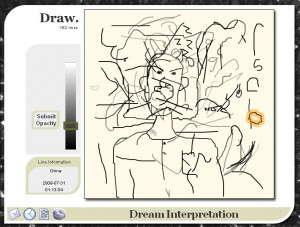 In my ongoing learning about visual thinking and visual practices I’m always delighted to be turned on to a new web based visual tool. SwarmSketch made me jump with joy. First, about the site:
In my ongoing learning about visual thinking and visual practices I’m always delighted to be turned on to a new web based visual tool. SwarmSketch made me jump with joy. First, about the site:
Welcome to SwarmSketch: Collective sketching of the collective consciousness.
SwarmSketch is an ongoing online canvas that explores the possibilities of distributed design by the masses. Each week it randomly chooses a popular search term which becomes the sketch subject for the week. In this way, the collective is sketching what the collective thought was important each week. A new sketch begins after one week, or after the previous sketch reaches one thousand lines, whichever comes first.
Each user can contribute a small amount of line per visit, then they are given the opportunity to vote on the opacity of lines submitted by other users. By voting, users moderate the input of other users, judging the quality of each line. The darkness of each line is the average of all its previous votes.
Dream Interpretation
2009-07-29We are currently sketching “Dream Interpretation“, come in and contribute a line.
Alternatively, you may like to browse the previous sketches and view animations of their progression.
SwarmSketch was developed by Peter Edmunds as part of an honours project at the University of Canberra. If you have any comments or suggestions, let me know: info AT swarmsketch DOT com.
What I love about this is that you are limited to contributing just one line of limited length. So it is about the collective set of lines, not YOUR line or my line. It asks us to create together, not show off our drawing skills. It limits destruction by one person. It is a fabulous visual metaphor for many online collaboration issues. Check it out!
When I first came across Twitter I couldn’t, for the life of me, figure out what I could use it for. Regardless, there was something about it that intrigued me, even if I couldn’t quite put my finger on it. It took a while, but I’ve been tweeting for over a year now and I have been making business cases for why it would be useful to my stodgy old company.
Somehow, this seems a bit similar – though I suspect it will have to morph into something a bit more structured before it would be (shall we say) useful. Don’t get me wrong, I like it just the way it is for sketching, but I could foresee something like this, after a period of development, being used as a design tool. Perhaps not for the kind of engineering my company does, but maybe for some areas of urban planning, design of recreational areas, things where lots of input is wanted and allowed while protecting each person’s input from capricious (or malicious) judgment.
Thoughts off the top of my feverish pate. Thanks for yet another fascinating piece . . . and link (I contributed to “Glass Frog”). It will be more satisfying to me when it provides texture, color, etc.
Rick
Rick, thanks for chiming in. Your notes were particularly relevant because yesterday I led a 4 hour F2F introduction to the use of graphic facilitation and shared drawing with a group of mediators.
It is more than design. It is using shared, co-created images to open the conversation. Words sometimes are tricky because we think we know what the other person means. With pictures, we more naturally assume we have different interpretations and experiences of the image and we start with negotiation of meaning. Does that make any sense?
Hi Nancy – Yes it does make a lot of sense. I wasn’t trying to be comprehensive; just throwing out what came off the top of my head. Your suggestion that it can be used to “open the conversation” brings other applications to mind. One, in particular, would be as a form of therapy. As the father of two young girls who are adopted from China – one of whom was nearly three when we brought her into our home and was clearly traumatized – I am always thinking about ways to help her grow and deal with what is mostly pre-verbal trauma. I find myself wondering if there wouldn’t be some sort of efficacy in this kind of a process (which would be available no mater where one’s located, as well as asynchronously) for small groups, etc. Maybe even as a family, perhaps with some professional guidance. Then again, I suppose a family could achieve the same results with paper and crayons. Again, I’m just throwing stuff out so I can respond without doing research and writing a thesis. Hence, the substantial probability I will sound crazy.
What I’m really getting at, I guess, is that so many of the “social” capabilities opening up because of our connectedness through the Internet, and the genius and creativity of countless people who are developing new services/applications, are also opening up new ways to work together, grow together, and enhance our lives and the lives of others. It seems a bit of a cliche, but I am referring to the emergent quality of what is taking place online. It’s so exciting I’m both energized and paralyzed at the same time.
Oh what a cool idea!
I used to play a Mr Squiggle type game which was similar (but closed and unlimited) while waiting for our attendees to log into our webinars, but this is like that on steroids, and in an open forum. As a predominantly visual communicator I love things like this, and as a student of networks etc, I find the possibilties and ideas behind it fascinating.